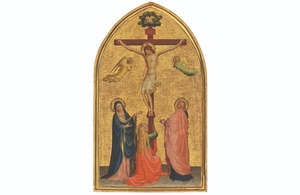Renaissance painting depicting The Crucifixion at risk of leaving the UK
A temporary export bar has been placed on a 15th century painting by Fra Angelico to allow time for a UK gallery or institution to acquire it.

- The painting is valued at over £5 million and dates from a formative period in the artist’s career
Arts and Heritage Minister Lord Parkinson of Whitley Bay has placed an export bar on a 15th-century painting, ‘The Crucifixion with the Virgin, Saint John the Evangelist and the Magdalen’ by Fra Angelico.
The painting, valued at over £5 million, is at risk of leaving the UK unless a domestic buyer can be found.
The work by the leading Renaissance artist Fra Angelico depicts Christ on the Cross surrounded by the Virgin Mary, Mary Magdalene, and Saint John the Evangelist. The luminous colours and refined composition are highly characteristic of Fra Angelico’s techniques, and the work, dated to the early 1420s, was painted at an important moment in Renaissance art.
The painting reflects Fra Angelico’s response to the intense period of creative innovation taking place at the time, when artists were developing new expressive and compelling forms of representation in religious and secular art.
Arts & Heritage Minister Lord Parkinson of Whitley Bay said:
This beautiful piece by such an important figure of the early Renaissance represents a key moment in the history of European painting.
It has been in the UK for two centuries, and I hope that a domestic buyer will come forward so that it can remain here to be studied and admired for generations to come.
The Minister’s decision follows the advice of the Reviewing Committee on the Export of Works of Art and Objects of Cultural Interest (RCEWA).
Committee member Christopher Baker said:
Fra Angelico was one of the great innovators in the evolution of early 15th-century Florentine art. This profoundly moving devotional work, with its delicate colour harmonies and deeply considered, expressive figures, demonstrates the enduring power of his achievement. It is an extraordinary rarity that assists with our understanding of a formative period in the artist’s career and in the development of Italian Renaissance painting more widely. Its appeal also extends far beyond such scholarship because of its numinous beauty.
Executed in tempera on a wooden panel, the painting retains its original frame and has been in Britain since the early 19th century. It would constitute a major addition to a UK public collection and every effort should be made if possible to acquire it.
The RCEWA made its recommendation on the basis that the painting met the second and third Waverley criteria for its outstanding aesthetic importance and its outstanding significance for the study of the development of painting in Italy in the early Renaissance.
The decision on the export licence application for the painting will be deferred for a period ending on 7 April 2024 (inclusive). At the end of the first deferral period owners will have a consideration period of 15 Business Days to consider any offer(s) to purchase the painting at the recommended price of £5,001,000 (plus VAT of £180,200 which can be reclaimed by an eligible institution). The second deferral period will commence following the signing of an Option Agreement and will last for six months.
Offers from public bodies for less than the recommended price through the private treaty sale arrangements, where appropriate, may also be considered by the Minister. Such purchases frequently offer substantial financial benefit to a public institution wishing to acquire the item.
Notes to editors
-
In December 2022, Lord Parkinson discussed the Waverley criteria in a speech to mark their 70th anniversary, and used the opportunity to invite thoughts on the way they work – for instance, whether the Committee should say more about how it has considered items’ connection to the history of other countries as well as to the UK’s, or whether the items it considers are destined for public display rather than private collection. His full speech can be found at: https://www.gov.uk/government/speeches/lord-parkinson-speech-at-a-reception-to-mark-70-years-of-the-waverley-criteria
-
Organisations or individuals interested in purchasing the painting should contact the RCEWA on 0207 2680534 or rcewa@artscouncil.org.uk
-
Details of the painting are as follows: Fra Angelico (active 1417; died 1455). ‘The Crucifixion’, early 1420s Tempera on panel, 59.7 x 34.2 cm. The painting retains its original engaged frame
-
Provenance: (Probably) William Bingham Baring, 2nd Lord Ashburton (1799-1864), Bath House, London; by inheritance to his widow, Louisa, Lady Ashburton (1827-1903), Kent House, London or Melchett Court, Hampshire; through her daughter, The Hon. Mary Florence Baring (1860-1902), wife of William Compton, 5th Marquess of Northampton (1851-1913), and their second son, Lord Spencer Compton (1893-1915) and by descent.
-
The Reviewing Committee on the Export of Works of Art and Objects of Cultural Interest is an independent body, serviced by the Arts Council (ACE), which advises the Secretary of State for Culture, Media and Sport on whether a cultural object, intended for export, is of national importance under specified criteria.
-
Arts Council England is the national development agency for creativity and culture. Its strategic vision in Let’s Create is that, by 2030, England should be a country in which the creativity of everyone is valued and given the chance to flourish and where everyone has access to a remarkable range of high-quality cultural experiences. ACE invests public money from the Government and the National Lottery to support the sector and deliver the vision. Following the Covid-19 crisis, ACE developed a £160 million Emergency Response Package, with nearly 90 per cent coming from the National Lottery, for organisations and individuals needing support. It is also one of the bodies administering the Government’s unprecedented Culture Recovery Fund.